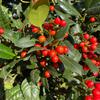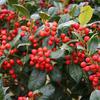Great choice! We're adding your items to the basket and working out what else you might need to plant it.
Holly ILEX NELLIE R STEVENS
Example photos only. Size, stem height and habit may vary.
Please contact us for photos of current stock.
Select plant type
Quantity
| Volume Discount | 1+ | 10+ | 50+ | 250+ |
|---|---|---|---|---|
| 18L pot / 80-100cm | £120.00 | £108.00 | £96.00 | £84.00 |
Product Description
ILEX X NELLIE R STEVENS
Characteristics
This evergreen holly with its handsome glossy leaves has been a popular in America for decades and is now becoming more popular in the UK for its vigorous growth and compact habit
It grows in a neat pyramidal shape to about 6m (20ft) in height. Ilex Nellie R Stevens is a hybrid between English holly (I. aquifolium) and Chinese holly (I. cornuta).
The leaves are thick and have teeth typically associated with the holly. This female holly is extremely fruitful and colourful when loaded with bright red berries in winter. It provides both food and nesting habitat for birds.
Where to grow
Hollies will grow in most well drained moist soils with good levels of organic matter and nutrients. They do not tolerate waterlogged ground particularly well and will do better if sheltered when small.
Did you know?
Ilex x Nellie R. Stevens was developed in Maryland and released to the nursery trade in 1954, it is quite popular in the southern United States as it is fairly heat and drought tolerant.
Features
-
Mature Height
- Small - 5-10 metres
-
Spread
- 0-5 metres
-
Shape / Habit
- Shrub Multi-Stem
-
Growth Rate
- Slow
-
Soil Type
- Chalk/Limestone
- Light sandy
-
Sun Levels
- Full sun
- Partial shade
-
Difficulty / Hard to Grow
- Medium
-
Evergreen / Deciduous
- Evergreen
-
Leaf Colour
- Green
-
Foliage
- Dense
-
Flower Colour
- White
-
Flowering Type
- Single
-
Flowering Month
- May
-
Berries / Fruit Colour
- Orange
-
Uses
- Screening
- Garden Tree
- Small garden Tree
- City/Urban Sites
- Bird Food
-
Hedging
- Evergreen Hedge
- Berrying Hedge
-
Thorny
- Yes
-
Season
- Winter
Aftercare
Pruning Ilex Nellie R Stevens
Ilex Nellie R Stevens will naturally form a conical shape, however, vigorous shoots can make the outline untidy so ideally clip each summer. Pruning will affect the abundance of berries.
Training as a standard with a central clear stem is possible. The number of years this will take will depend on the height of clear stem desired. Each year remove the lowest lateral stems, as well as any vigorous shoots that pose as a competing leader
What time of year should I prune? Pruning is best done in summer
For the continued healthy growth of your trees, shrubs or hedging it is vital that you follow the advice below.
Watering
The main reason that plants die within 12 months of having been planted is lack of water. It is essential throughout the spring and summer, to give a heavy enough watering to enable the water to penetrate right down to the deepest root level of the tree. In hot dry spells give the equivalent of 2 bucketfuls every three days.
Weed Control
One of the most common causes of lack of water is competition from grass. When trees are first establishing, the grass roots would be at the same level as the tree roots and are far more efficient at taking up water and thus choke the tree. It is vital that for at least 3 years after planting your tree or hedge has a circle or strip one metre wide completely free of grass.
- Mulch mats are an effective way to stop grass and weeds, although they will require a careful eye to make sure they continue to work. After clearing the ground around the tree, firmly fit the mat by tucking the edges into the soil and put a thick layer of bark mulch on top of this. Be careful not to allow the woodchip to touch the stem as it can cause rot.
- Weed killer is very effective, however it is harmful to the environment. Organic weed killers usually do not kill roots. Weed killer needs to be applied each year for the first 3 years, preferably when the tree is dormant, or just once before applying a mulch mat.
- Mowing or strimming is NOT an answer to the problem. Each time you mow, the grass will grow back more vigorously and strimming invariably leads to lacerated trunks.
Staking
If trees are not correctly secured they will rock in the planting pit. Roots not firmly in contact with the soil are unable to take up moisture and nutrients, resulting in die back or death of the tree. Check, particularly after windy weather, that stakes are still solidly in the ground keeping the base of the trunk firm. The purpose of the stakes is to anchor the roots. Flexing in the wind, higher up the trunk, is not necessarily a problem if the roots are firm.
Bellow is list of the correct system to use to secure your trees.
- 40/60, 60/80, 80/100 whips - Unless rabbit/deer problem no need to stake.
- 100/125, 125/150 1.2m Cane and Easi tie.
- 150/175 1.2m square stake and a buckle tie and spacer.
- 175/250, 6/8, 8/10 15L 1.65 Tree stake and a buckle tie and spacer.
- All larger trees. 2 x 1.65 Tree stake and cross rail with 38mm cushion spacer and 1m of 38mm strapping.
Ties
Always use our recommended tree ties or strapping. These are designed and manufactured with the correct amount of give to hold the tree firm without strangling it. They should be checked at the end of each growing season for adjustment as the trunk thickens. Non proprietary materials such as baler twine will cut into the bark and should not be used.
Protection from Animal Damage
Rabbits, deer, sheep, cattle and horses can all potentially damage trees. Ask us for advice on the most appropriate guards for your trees or hedge. Squirrels are also a terrible pest when trees get to about 20ft tall but there is no protection available.
Are the delivery costs the same no matter how many plants I order?
Yes the delivery costs stay the same no matter how many plants you have on your order. They are worked out based on your distance from our nursery and can be found here.



